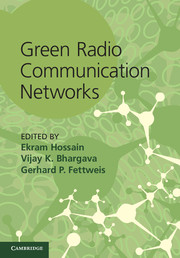Book contents
- Frontmatter
- Contents
- List of contributors
- Preface
- Part I Communication architectures and models for green radio networks
- 1 Fundamental trade-offs on the design of green radio networks
- 2 Algorithms for energy-harvesting wireless networks
- 3 PHY and MAC layer optimization for energy-harvesting wireless networks
- 4 Mechanical relaying techniques in cellular wireless networks
- Part II Physical communications techniques for green radio networks
- Part III Base station power-management techniques for green radio networks
- Part IV Wireless access techniques for green radio networks
- Part V Green radio test-bed, experimental results, and standardization activities
- Index
- References
3 - PHY and MAC layer optimization for energy-harvesting wireless networks
from Part I - Communication architectures and models for green radio networks
Published online by Cambridge University Press: 05 August 2012
- Frontmatter
- Contents
- List of contributors
- Preface
- Part I Communication architectures and models for green radio networks
- 1 Fundamental trade-offs on the design of green radio networks
- 2 Algorithms for energy-harvesting wireless networks
- 3 PHY and MAC layer optimization for energy-harvesting wireless networks
- 4 Mechanical relaying techniques in cellular wireless networks
- Part II Physical communications techniques for green radio networks
- Part III Base station power-management techniques for green radio networks
- Part IV Wireless access techniques for green radio networks
- Part V Green radio test-bed, experimental results, and standardization activities
- Index
- References
Summary
Introduction
In typical wireless communication systems, nodes are deployed with pre-charged batteries. The energy stored in the battery is used by the node for communication, sensing, and signal processing tasks. However, when the battery drains out, the node “dies” and is no longer available in the network. When a sufficient number of nodes die, the network itself becomes dysfunctional. Therefore, periodic maintenance and battery replacement are necessary to ensure that the network continues to operate. Such maintenance is often operationally challenging or even impossible in several network deployments. The alternative option of running power cables to the nodes is also often infeasible.
An emerging green alternative that circumvents this problem is the use of energyharvesting (EH) functionality in the nodes [1]–[7]. An EH node harvests energy from the environment using solar, thermoelectric effects, vibration, and other phenomena. Unlike a conventional node, an EH node that drains out its battery can harvest energy later and, thus, again become “alive.” Energy harvesting eliminates the need for periodic battery replacements and significantly decreases the network maintenance overhead. This also makes it an attractive alternative to wireless networks that are powered by external power cables. Consequently, EH networks are finding applications in monitoring systems in aerospace, automobile, and civil applications, environmental/habitat monitoring, intrusion detection, inventory management, etc.
Unlike a conventional battery-operated node, a potentially infinite amount of energy is available to an EH node, albeit over an infinite duration of time. Hence, the focus of the physical layer and multiple access (MAC) layer protocols shifts to judiciously utilizing the harvested energy and ensuring that the energy is available when required – to the extent possible. Reducing the energy consumption and improving the spectral efficiency now become secondary goals of the design of these protocols. This motivates a redesign of the physical and multiple access layers of the network. For example, increasing the transmit energy improves the reliability of transmissions by a node as it counters noise. However, it also drains the node’s battery faster and lowers the odds that the node can transmit later. In a multi-node network, an additional multiple access problem that arises is the determination of which node(s) should transmit and when to transmit.
Information
- Type
- Chapter
- Information
- Green Radio Communication Networks , pp. 53 - 77Publisher: Cambridge University PressPrint publication year: 2012
